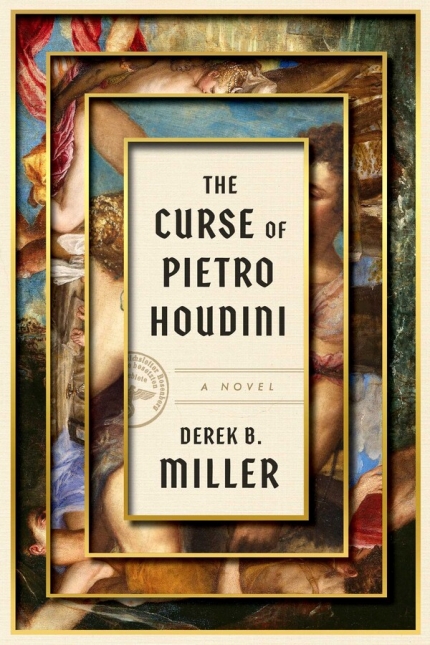The Curse of Pietro Houdini: A Novel
- By Derek B. Miller
- Avid Reader Press
- 384 pp.
- Reviewed by Mark Gamin
- February 1, 2024
Needlessly murky plot points mar this otherwise clever art-heist tale.

Funny how even avid readers — the couple-of-books-a-week nutballs who regularly pore over reviews in the New York Times, the Wall Street Journal, and (hopefully) the Independent — can miss an author they should know about. In this case, it’s a guy who’s won prizes and written some sophisticated, wryly suspenseful novels, including American by Day (involving the odd but telling differences between Scandinavian and U.S. crime-fighting) and The Girl in Green (addressing the surreality of war).
Introducing (if only to me, but maybe to you, too): Derek B. Miller.
Some of his earlier novels (he has published six) use occasionally recurring characters, but that seems not to be the case in his latest, The Curse of Pietro Houdini. The new book does, though, adhere to a frontispiece formula Miller has employed before: “Inspired by many actual events.”
This allows him — he makes no bones about it — to drape his narrative over a particular framework and to pick and choose among (or create) facts to suit his fancy. There’s nothing wrong with that, and Miller acknowledges, post-script, his borrowings in sometimes excessive detail.
The setting this time around is Italy in World War II, primarily Montecassino, an abbey founded by St. Benedict that’s full of invaluable artwork — indeed, it’s “one of the greatest repositories of culture on earth,” says the titular Pietro Houdini. His provenance is unclear, and it’s something he guards with gnomic misdirection. Nominally a professor of chemistry, Pietro has been assigned by the Vatican to restore the paintings and frescoes at Montecassino, or so he claims. He is, after all, according to his 14-year-old companion, a bit of a P.T. Barnum.
That companion is also opaque as a character, with both name and gender a mystery. For the first hundred pages, he’s Massimo, though the author continually drops hints that the boy is really a girl. (This kind of thing can be intriguing or merely vexatious; Miller walks a fine line.) Later, Massimo embraces femininity, mostly as protection from Nazis looking for Italian conscripts, and is dubbed Eva. Muddying the waters further? While Massimo/Eva narrates long stretches of the story, an omniscient voice inexplicably takes over in places.
Two important rules pertain to the business of reviewing novels: 1) Don’t reveal too much of the plot, and 2) Don’t spoil surprises — not only surprise endings, but any surprises.
As to the first: No worries. The Curse of Pietro Houdini is too dense and complicated (and farfetched) to summarize in 800 words. But briefly: The Germans remove the Montecassino paintings, not necessarily to loot them, but maybe to protect them from the Allies, who are now, in 1943, marching up Italy’s bootheel. Pietro determines to steal three masterpieces by Tiziano (Titian to Americans) by painting over them. He entrusts the concealed works to Massimo/Eva, who, along with a band of companions, survives the war. The paintings do, too, but not the abbey, which, in one of those “inspired by many actual events” bits, is obliterated by Allied bombers after being unwittingly pointed out by Eva herself.
As to the second, no-spoilers rule: If the reviewer doesn’t understand the more confounding plot devices — Massimo’s apparent sex change; the fact that Pietro is Mussolini’s cousin; a random mention of Pietro’s wife’s middle name, Beatrice (after Dante’s?) — and this reviewer doesn’t, you can’t accuse him of willfully spoiling anything.
None of this is to suggest the novel isn’t entertaining. It is, manifestly so. And parts of the proceedings are clearly meant to be fanciful, magical, or dreamlike — things that come from the same literary toolkit Miller used so well in The Girl in Green. But in The Curse of Pietro Houdini, he’s hiding the ball when he didn’t need to. The book has great charms but doesn’t reveal them easily. The reader must work to uncover them.
Mark Gamin is a lawyer, writer, and editor. He lives sometimes in northeastern Ohio and sometimes in southeastern Ohio.
_80_120.png)
